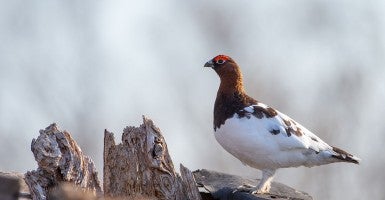HOXIE, Kan.—These days, when Kyle Randa scouts a new location for an oil well, his schedule is a little different.
He still gets up early to drive out to the spot. But rather than get right to work, he sits for a few hours and listens. And hopes he doesn’t hear the booming call of the now-infamous lesser prairie chicken.
Like countless others in western Kansas, Randa’s job has been upended by a U.S. Fish and Wildlife Service decision last March to list this small grouse as a threatened species. With the decision came new rules, regulations and the threat of fines for disturbing the bird.
Folks in the oil and gas industry are now restricted where they can work—it costs as much as $45,000 in fines to tear up a single acre of lesser prairie chicken habitat. But it goes beyond that. Randa, who works for Mull Drilling of Ness City, used to start his days by 6 a.m. or earlier, but now he and other oil patch workers are barred from going anywhere near a rig before 9 a.m.
What happens if, say, there’s a fire? Randa just shrugs and said it’s not worth inviting fines. They’ll just wait it out.
Under the scorching summer sun, restricted hours mean hotter, longer days with fewer jobs to go around.
“It’s going to change our lifestyle, how we operate,” Randa said. “They’re trying to set the hours you can work. They’re going to restrict where you can and where you can’t work. We don’t work 9-5.”
Although the initial impact of the USFWS ruling is being felt by the energy industry, a ripple effect is inevitable. Oil and gas are huge economic factors in communities across western Kansas. They provide not only reliable employment, but make up a substantial chunk of the tax base. Ed Cross, president of the Kansas Independent Oil and Gas Association, said in July 2013 the industry employs as many as 67,000 Kansans.
Until May 12, at least some of those jobs were spread across about 15 oil wells near Oakley, right in the heart of lesser prairie chicken habitat.
“We stopped because we don’t want to be their [USFWS] poster boy,” said Mark Hammerschmidt, a driller with Pelican Hill Oil and Gas.
“We’ve got guys on drilling units that don’t have jobs now because there’s so many that have backed off,” he said. “Each well, you’re affecting maybe 100 people by the time you get all the service, all the guys on the rig. There’s a whole lot more to it than just drilling a hole and putting a pumping unit on it. There’s a lot of service industries that are affected by this.”
But even more unsettling than the threat of fines—which can range upwards of $25,000 for just disturbing a lesser prairie chicken, Randa said—is the uncertainty. Folks aren’t sure exactly how things will be enforced and just how closely the federal government will follow the letter of the law.
But if you ask Jim Carlson, the whole decision is wrong from the start.
Carlson heads the Kansas Natural Resource Coalition, a group of 31 Kansas counties that have banded together to fight the perceived power grab by the federal government.
“The science doesn’t support the listing,” Carlson told a crowd of worried individuals during a KNRC meeting in Hoxie on Thursday.
The official USFWS report detailing the lesser prairie chicken listing is a staggering 600 pages long, but at the very core is one simple number: 18,000. That’s how many birds government officials say they counted in Kansas last year, down from 34,000 birds counted in 2012.
Here’s a secret: In reality, they have no way of knowing just how many lesser prairie chickens reside in Kansas, and the methodology they use to count the birds is shaky at best.
According to surveys conducted by the Kansas Department of Wildlife, Parks and Tourism, the birds are counted by listening for their calls within a given area, under a few assumptions:
- Only males are counted
- All males attend leks (mating grounds)
- There are as many females as males
- All leks within the survey area are detected.
“I’ve lived basically my whole life in Ness County, and we have more prairie chicken today than I have ever seen before,” Randa said. “We haven’t seen a decline in the numbers, we’ve seen the opposite.”
Sheila Ellis, rancher and KNRC research analyst, said the lesser prairie chicken saw population declines during the Dust Bowl of the 1930s, but with the return of moisture came an increase in the bird’s numbers. At this point, the fate of the lesser prairie chicken is tied to the livelihood and economics of western Kansas and ultimately probably will be decided in court.
Until then, Randa is just doing his job, which he says has come under the watchful eye of Big Brother. In recent months, plain white SUVs bearing government plates have dotted a distant roadside near his job sites; small planes have passed and circled overhead.
“We’ve been seeing a lot of government vehicles. I think they’re observing, somewhat,” Randa said. “I guess we can only say what we’re seeing, but it definitely feels like we’re being observed. And I’ve never had that feeling before.”
“The heavy hand of the Endangered Species Act will not make it rain,” KNRC President Ken Klemm said.
Driving through western Kansas, it’s painfully clear how a multiyear drought has gripped the region. Wheat harvest is only days away, but stalks of grain that should be chest high barely reach the knees.
Randa readily admits he’s not a scientist, be he likes to think he has a feel for the wildlife around him.
KDWPT’s surveys even admit “it is likely that some of these assumptions are being violated and as a result the density estimates are probably biased (most likely low).”































